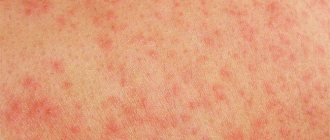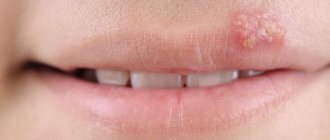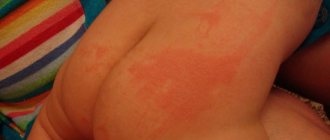Treatment of allergies on a child's face
Allergy treatment is a process that must be carried out under the supervision of an allergist and pediatrician. Doctors will draw up a recovery program and normalize the functioning of your baby’s body. This process can last quite a long time and, moreover, does not lead to the rapid disappearance of such unpleasant things for the child as itching, peeling and redness. Special children's cosmetic creams and gels "La-Cri" will help hide these unpleasant ailments.
La-Cri products are effective and, most importantly, absolutely safe for the health of children. Their quality is confirmed by a certificate of state registration and a number of studies by the AILC of the Federal State Institution “R.R. Vreden Russian Research Institute of Traumatology and Orthopedics”. The quality of “La-Cri” allows them to be used for those babies who have just been born.
Preventive measures
To reduce the risk of allergic reactions, it is necessary to closely monitor the child’s diet and his household environment.
- If a nursing mother has any allergy symptoms, it is important to regularly visit a doctor and follow a diet. It is recommended to exclude from the diet foods that are potential allergens, for example: milk, honey, chocolate, nuts, seafood, citrus fruits, cereals, as well as products with flavorings and flavor enhancers.
- If breastfeeding is not possible, you should entrust the choice of infant formula to a specialist.
- If a child’s allergy has already been identified, limit contact with the allergen and eliminate potentially dangerous foods from the diet.
- Regularly carry out wet cleaning, vacuum the furniture and prevent the formation of mold.
- Do not skimp on hygiene products for children and household chemicals. Choose products marked “hypoallergenic”.
- Get rid of excess dust “accumulators”: carpets, soft toys, heavy curtains.
- Replace synthetic bedding with natural cotton. Pillows, mattress and blanket should be hypoallergenic.
- Maintain room humidity at least 50%.
- Don't smoke in front of your child!
- In case of seasonal allergies to pollen or tree fluff, it is recommended to ventilate the room only after rain. A good solution would be to install an air conditioner.
- Be careful when letting your child try new foods. Update your diet gradually, in small portions.
Be sure to keep antihistamines in your medicine cabinet, but refrain from choosing your own medication! Entrust this important task to your doctor.
Take care of your child’s health, but don’t worry if an allergy does show up. This diagnosis does not interfere with comfortable development - just avoid allergens and follow the recommendations of a specialist!
Clinical researches
TM La-Cri products are recommended by the Union of Pediatricians of Russia. Clinical studies conducted by specialists have proven the high efficiency, safety and tolerability of products, including for daily skin care of children with mild and moderate forms of atopic dermatitis and during remission, accompanied by a decrease in the quality of life of patients. As a result of therapy, a decrease in the activity of the inflammatory process, a decrease in dryness, itching and flaking was noted.
Sources:
- Fokina R.A., Atopic dermatitis: stages of development of classification forms, Siberian Medical Journal, 2007
- A.N. Pampura, A.A. Chuslyaeva, Modern approaches to the treatment of atopic dermatitis in children
- N.L. Rybkina, Modern approaches to newborn skin care: pediatrician tactics, journal Bulletin of Modern Clinical Medicine, 2014
- I.I. Ryumina, V.V. Zubkov, Newborn skin care, Healthy Child magazine, 2017
Photos of allergies in children
Photo album on the diseaseAllergies in children: features and causes
Just a couple of centuries ago, the world did not even know what an allergy was, but today every third child suffers from it. At the same time, the symptoms of the disease often pass “under the guise” of completely different diseases, which can lead down the wrong path of treatment. So how not to confuse childhood diseases and identify their real cause?
How does it arise
All allergic reactions can develop in at least 4 ways, but in this article we will talk about the first and most common of them - the IgE-dependent way.
The characteristics of a child’s body, especially in the 1st year of life, normally protect the child from the development of allergies. The immune system is designed in such a way as to “introduce” the baby to the abundance of surrounding antigens, without causing pathological conditions.
In some cases, this mechanism fails, which may be due to:
- heredity (one parent “with allergies” - 30% risk of pathology in the child, both parents - 60% risk);
- violation of the barrier function of mucous membranes;
- innate characteristics of immunity.
In this case, at the first “meeting” with an allergen, the body only “remembers the unpleasant object” (begins the synthesis of IgE antibodies to the allergen), and the second time it “attacks” it.
The protection mechanism is implemented due to biologically active substances released by cells “on command” of IgE antibodies, and manifests itself:
- expansion of capillaries and increase in their permeability = redness and swelling (to accelerate the entry of immune cells into the lesion),
- irritation of nerve endings and spasmodic contraction of the “target” muscles = itching, coughing, sneezing (as a way to mechanically “get rid” of the allergen),
- increased mucus production = runny nose (to facilitate binding and removal of the “irritating” object).
Interestingly, allergies and acute respiratory viral infections have similar “points of application”. This causes the similarity of symptoms, as well as the tendency of allergy sufferers to acute respiratory diseases.
Symptoms and causes
Conventionally, allergic diseases can be divided into respiratory (inhaled antigens) and food. Symptoms of the former range from a slight runny nose to severe suffocation, while the latter have skin and “digestive” manifestations.
A “respiratory” allergy in a child can manifest itself not only with classic symptoms, but also simply with a “constantly stuffy nose,” and the cause may be:
1.mites (house dust, feather duster, flour mite and others)
This allergy appears upon contact with dust (household dust, books) and carpets, and most often occurs in a certain room.
2.down and feathers of birds
The reaction can be associated with both live birds (parrots, canaries and others) and with bedding (pillows and blankets), in which down and feathers are used as filler. In the second case, the allergy most often manifests itself during sleep and immediately after waking up (nasal congestion or cough that goes away during the day)
3.dander and epithelium of animals (cats, dogs, hamsters, guinea pigs, horses, etc.).
At the same time, wool (hairs) itself is safe in the context of allergies. The reaction is caused by skin elements that accumulate on the fur.
4. “domestic” molds
They live in warm, damp and poorly ventilated places in the room: seams between tiles in the bathroom and the space under the wallpaper of “damp” walls. Symptoms are often severe and only subside with prolonged stay outside the “allergenic” room.
5.trees and grass
Allergies are seasonal and appear during the flowering period of the plant: late spring, summer or early autumn.
Skin symptoms, in mild cases, consist of an itchy rash that goes away when the allergen is eliminated. And more severe reactions are accompanied by the development of dermatitis, which is characterized by a chronic course and is difficult to treat.
Thus, bowel irregularities, abdominal pain, as well as nausea and loss of appetite in a child may well be signs of an allergy and require a comprehensive examination.
Among the most “significant” food allergens in children are:
1. cow's milk proteins : β-lactoglobulin, a-lactalbumin, bovine serum albumin, and casein.
Depending on the reaction to certain proteins, dairy products should be excluded partially or completely.
2.chicken egg whites : ovomucoid, ovalbumin, lysozyme.
3.nuts;
4.cereal proteins, especially gliadin (gluten) of wheat and rye, barley and oats;
5.fish and seafood;
6.cocoa, citrus fruits and soy.
Diagnostics
It is often not possible to distinguish allergies from similar diseases by eye. “Experimentally” confirming the allergenic nature of symptoms can only be done by eliminating the “suspected” allergen. And in cases where there is none, laboratory tests can help in diagnosis.
The first stage of diagnosis serves to confirm the allergic nature of the disease and is based on:
1.1 General blood test with leukocyte formula, where eosinophils serve as a marker of allergy.
1.2. A blood test for immunoglobulin E, total and eosinophilic cationic protein, which increases tens and hundreds of times during allergies.
1.3. Microscopic examination of nasal secretions (nasal swab), also aimed at identifying eosinophils.
After establishing allergy as the main diagnosis, you can move on to determining the subgroup or the allergen itself.
The first option is used in case of doubt regarding the source of the allergy, and prefabricated panels are used to narrow the “search circle”. They contain several representatives of an allergy group at once, and the result is given in one number.
These may be allergen panels
- herbs,
- trees,
- animals,
- ticks,
- mold fungi,
- meat,
- dairy,
- citrus
- and many others.
If you receive increased results in any of the panels, you can proceed to the third stage of diagnosis - identifying the allergen itself. To do this, use a blood test for IgE to individual allergens (for example, a specific mold or a representative of citrus fruits).
What is a food allergy?
Food allergy (FA) is a pathological reaction caused by the intake of a food product, which is based on immune mechanisms. This means that some children's immune systems respond with hypersensitivity reactions to certain foods.
The maximum incidence of food allergies occurs in the first year of life. Often, the first symptoms of food allergy appear already in a child’s first three months of life (up to 25%) with the introduction of formulas based on cow’s milk protein (CMP). The second peak in the frequency of detection of food allergies in infants occurs at 6–9 months of life (up to 20%).
These products have a number of important qualities
- meet the functional requirements for nutrients, vitamins and minerals;
- made from natural, environmentally friendly raw materials, without the use of GMOs, without dyes, without flavors, without preservatives, without thickeners, without sugar;
- are monocomponent;
- their consistency and homogeneity corresponds to the physiological characteristics of the child’s age;
- have low immunogenicity.
Knowledge of the causes of the development of allergic reactions and the first symptoms of food allergies allows parents to promptly consult a doctor for advice and receive modern scientifically based recommendations for the diagnosis and treatment of food allergies, and the development of a diet that meets the current needs of the child.
Parents' first steps after food allergy symptoms appear
You should not independently establish a “diagnosis of food allergy”, refuse breastfeeding, a nursing mother should not “test” herself with self-prescribed hypoallergenic diets, offer her child and often change milk formulas on the advice of “experienced people”. Of course, you should consult a specialist - a pediatrician, allergist-immunologist.
Parents can first analyze whether there is a family history of allergies, what is the duration of breastfeeding, the child’s diet from the moment of birth, what milk formulas were introduced into the child’s diet, whether a food diary was kept, when the first symptoms appeared, what is their severity, whether there is a connection with food . This information should be provided to your doctor during your visit.
Is it necessary to go to the doctor right away? What examinations can he order?
Considering that the first months of life are critical in the formation of a child’s allergic immune reactions, of course you should consult a pediatrician as soon as possible. You may need to consult an allergist-immunologist, dermatologist, or gastroenterologist. If the doctor suspects a food allergy, a diagnostic elimination diet will initially be prescribed for 2–4 weeks and a food diary will be kept. If a food allergy is confirmed to a specific product, the duration of the elimination diet is determined individually and should be at least 6–12 months.
For a child with food allergies who is bottle-fed, the correct prescription of the medicinal formula is especially important. The doctor has information about the types, composition, indications for therapeutic nutrition (highly hydrolyzed mixture, amino acid mixture). After the symptoms of food allergy have been relieved, the question of the time and rules for the diagnostic administration of a causally significant product is within the competence of a pediatrician, allergist-immunologist.
It is possible that additional laboratory and instrumental research methods will be required to identify the entire spectrum of causally significant allergens. The feasibility and necessity of which will also be determined and explained by a specialist.
A pressing question for parents of a baby with food allergies is which complementary foods can be introduced. Current scientific evidence indicates that strict elimination diets in infancy have no benefits for the child. At the same time, the role of complementary feeding products is still being researched and caution should be exercised when introducing allergenic complementary feeding products to a child with a history of allergic reactions or primary manifestations of food allergies. It is correct to determine the time, type, dose, and schedule of administration of the supplementation product by a doctor with subsequent monitoring of the child’s condition.
For children with clinical manifestations of food allergies, modern industrial complementary feeding products recommended as first choice can be recommended:
- Vegetable puree (zucchini, cauliflower, broccoli)
- Grain complementary foods (dairy-free rice, corn, buckwheat porridge)
- Rabbit and turkey puree
- Fruit puree (apple, pear, plum)











